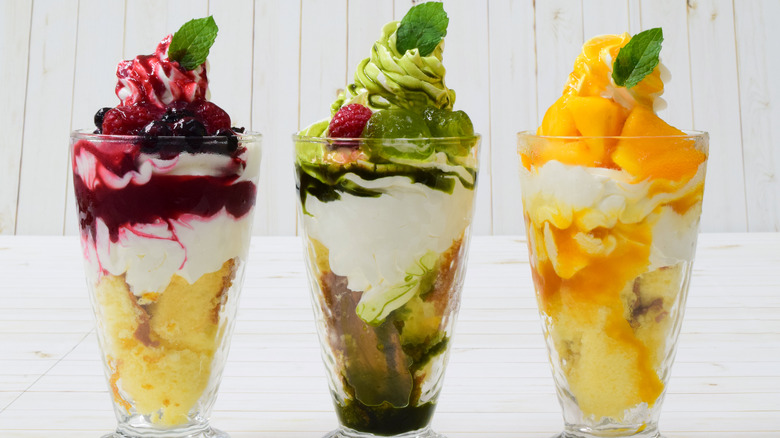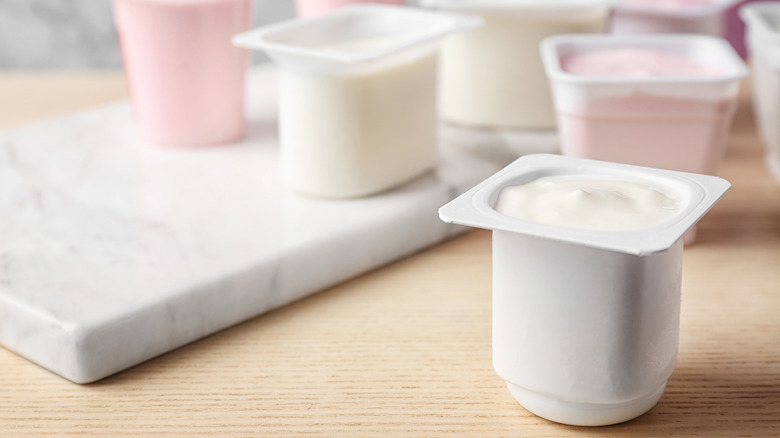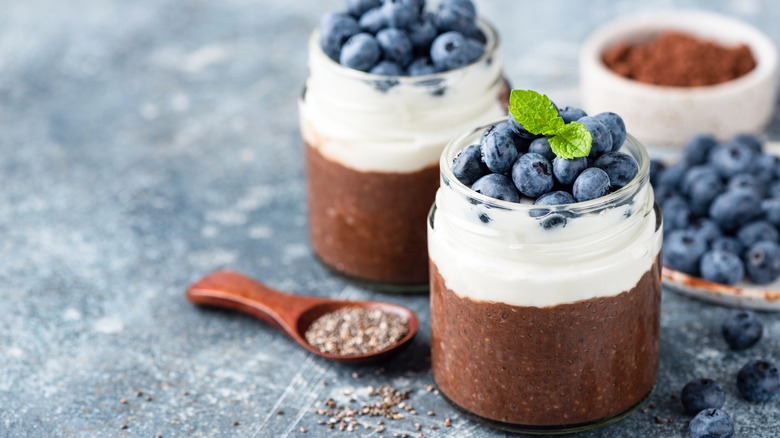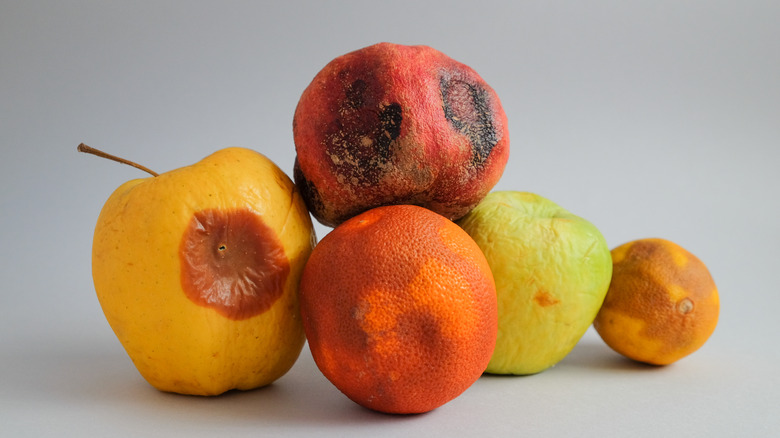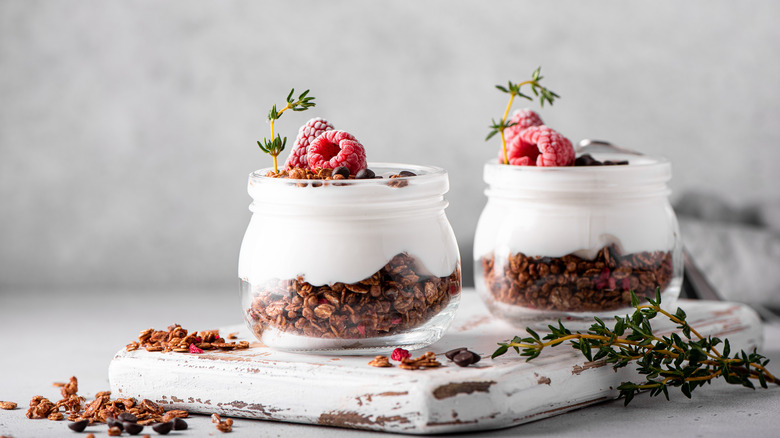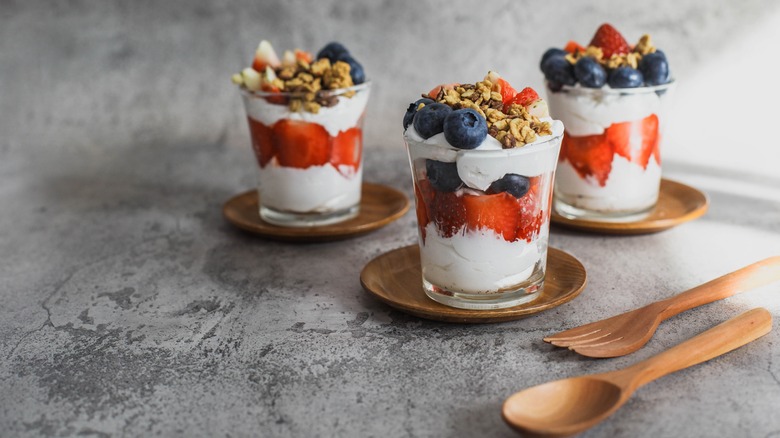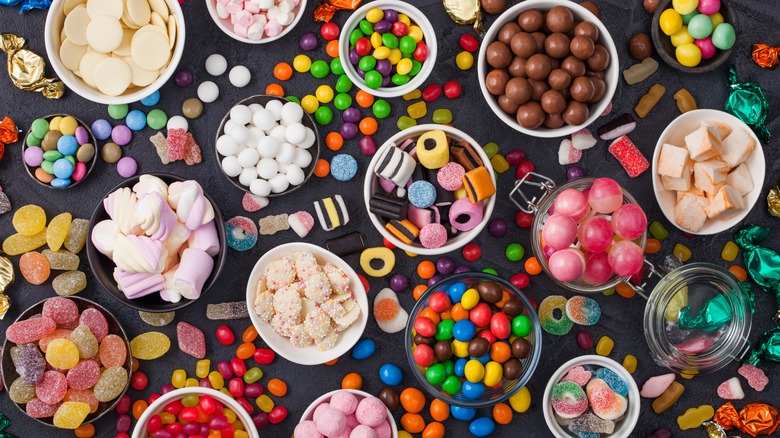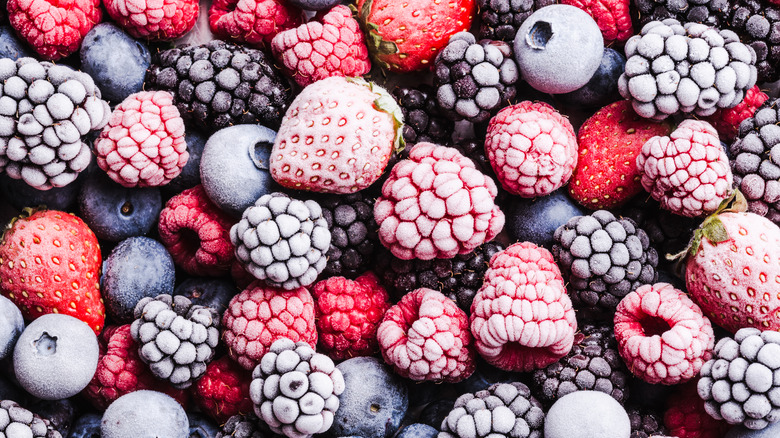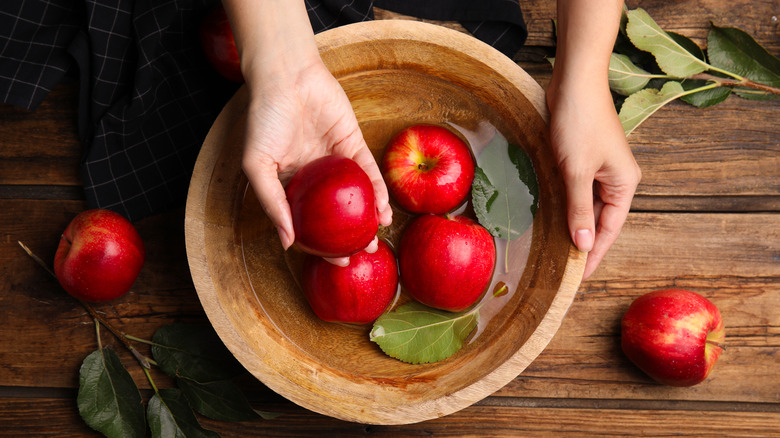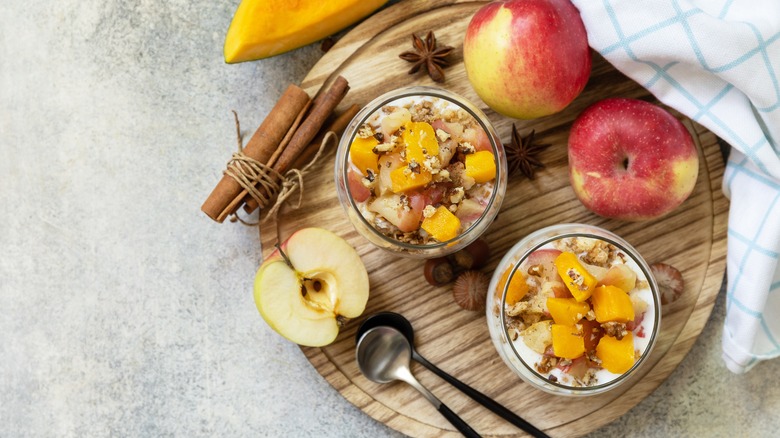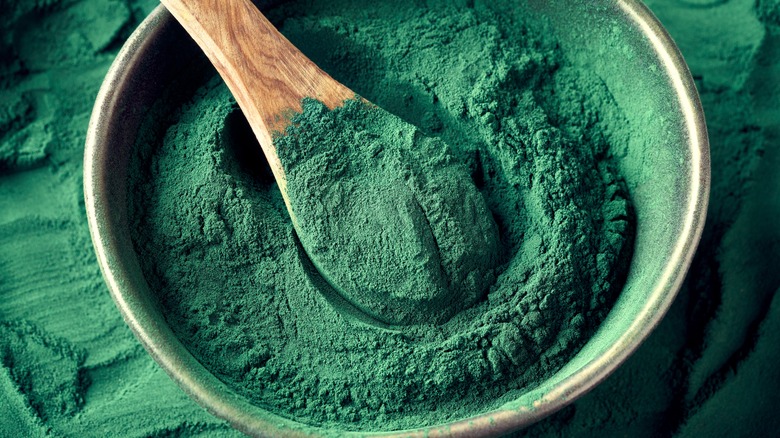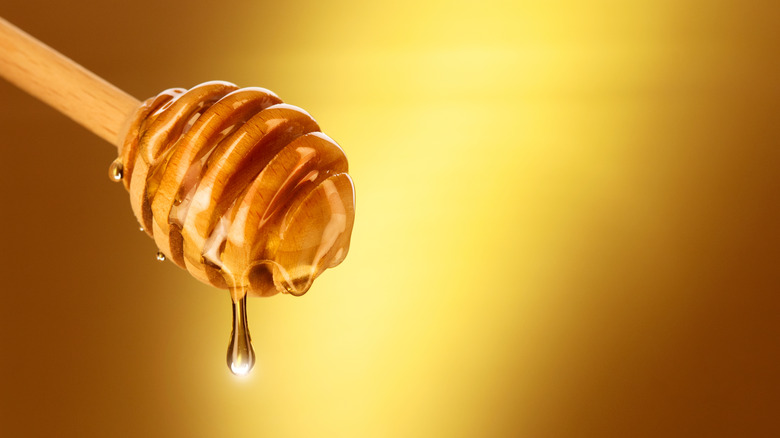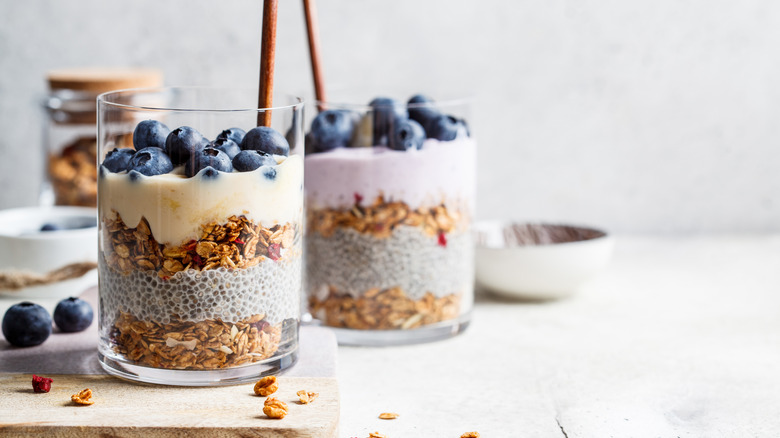12 Tips You Need To Build A Better Parfait
In the United States, there's a long and storied history of cooks putting their own spin on traditional cuisines from other countries and cultures. Whether we look at broad mashups like the blend of Mexican and American Southwestern cooking that comes together in Tex-Mex-style food, or individual items like Cincinnati chili, taking international flavors and ingredients and infusing them with an American twist brilliantly illustrates the melting pot of cultures that make up the U.S.
One such example is a dessert with French origins whose name, according to Merriam Webster, translates to English as "perfect": the parfait. The original French parfait shares some similarities with its American cousin. French parfaits consist of custard, which is made by boiling down egg, sugar, cream, and syrup to create a smooth puree that is not stirred prior to freezing. While the custard can be flavored with anything from coffee to fruit juice to liqueur, additional toppings are not typically included.
The American parfait is also structured around a creamy base, but it doesn't need to be custard — yogurt, ice cream, whipped cream, and pudding are all acceptable alternatives. Toppings and mix-ins are where the modern American parfait really differentiates itself from the French version. These parfaits are often topped with fresh fruit, granola, and whipped cream, and there are no hard-and-fast rules for add-ons. They can be savory, like this cucumber yogurt parfait; sweet, like this candy corn parfait; or anything in between. Let's look at some tips and tricks for taking your parfait game to the next level.
Decide on a base
If you're thinking about making parfaits, chances are you already have a rough idea of what you want to do. Are you searching for a nutritious, protein-packed breakfast? Have you been asked to bring a dessert to a potluck gathering? Perhaps you're just looking for a yummy, late-night snack that can be thrown together without much prep work. A parfait's base is what brings the entire concoction together, and as such, it's an important piece of the puzzle.
There are quite a few factors to consider when choosing a base for your parfait. If nutrition is a concern, think about using yogurt as your base. Using Greek yogurt in a parfait helps to jam-pack it with protein, probiotics, and other health benefits (per Medical News Today), while dairy-free yogurt (coconut, almond) can be used for both sweet and savory parfaits and makes a nice option for those who are vegan or dairy-sensitive. If you're making dessert parfaits, ice cream and whipped cream make lavish bases, but will ice cream be too thick? Is whipped cream dense enough to carry your other toppings? Mousse, pudding, sorbet, and custard can all be used for bases — it all depends on the flavor profile, structure, toppings, and overall purpose of your parfait.
Match your toppings to your base
Once you've selected a base, it's time to pick your mix-ins and toppings. As mentioned above, the sky's the limit when it comes to layering up your parfait, but you'll want to ensure that your additional ingredients complement rather than detract from your chosen base. The tangy, sourish quality of plain Greek yogurt may not pair well with ultra-rich toppings like dark chocolate, while the sweetness of butterscotch custard would be an unpleasant addition to a savory parfait.
If you're going for a breakfast vibe, consider using yogurt as a base with the classic additions of granola and fruit or berries layered in. For sweeter, dessert-forward parfaits, think about using a lighter, airier base like chocolate mousse or whipped cream to offset already-saccharine toppings, such as crumbled Oreos or chocolate chips — or just go for it and layer ice cream with crushed graham crackers and candied pecans. Flavored bases like strawberry ice cream or peach yogurt are 100% allowed, but bear in mind that any flavors in your base will, of course, affect the taste of your overall dish.
Use fresh, high-quality ingredients
Don't skimp on quality! "Quality" doesn't have to mean using ice cream that costs $10 a pint or splurging on the finest dark chocolate in the land, but make sure that all of your ingredients are up to scratch. If possible, using brands and products you're familiar with (and enjoy) is ideal. This may not be the best time to experiment with a new flavor of gelato or to finally try out that new superfood you've been hearing about. Tried-and-true is the name of the game.
Quality also means using fresh ingredients. It might sound like a no-brainer, but using expired yogurt, rotted fruit, or rancid nuts is a surefire way to land your parfait in the trash. Check expiration dates, examine perishables for telltale signs of spoiling, and make sure dry ingredients haven't gone stale before you begin to assemble your parfait — you don't want to find yourself halfway through constructing a parfait (or a whole tray of them) only to discover patches of white fuzz on your raspberries! While "sell by," "use by," and "best by" labels don't actually refer to the date on which products go bad, they can provide a decent sense of where food products are at regarding their shelf lives. Overall, trust your instincts — if it looks and smells spoiled, it probably is.
Incorporate ingredients with different textures
The one thing that almost all American parfaits have in common is a creamy base (although some recipes, like this overnight oats parfait, use bases with a slightly chunkier texture). This is part of the magic of parfaits, but incorporating toppings and mix-ins with different textures really helps to create an optimal mouthfeel. The crisp bite of a ripe green apple will stand out against the airy quality of whipped cream, while crunchy granola or chopped nuts creates a satisfying crackle when paired with thick, creamy yogurt. The feeling of a mouthful of mini chocolate chips contrasted with a bite of velvety coconut ice cream is absolutely delightful.
These textural contrasts may already be present in your base — many yogurts, for example, already contain berries or fruit, and there's a whole world of wonderfully strange ice cream flavors and mix-ins to play with. The more the merrier! Make a game of seeing how many textures you can incorporate into your parfait, and we're willing to bet you'll be pleased with the results.
Pick the right container
The traditional way to serve a parfait is to layer up the base and toppings in wide-mouthed glass stemware. This makes for a lovely presentation, as it's easy to see the distinct layers of yogurt, ice cream, whipped cream, or whatever base you've chosen contrasted with fruit, granola, and other toppings. A long-handled spoon, like those used for milkshakes, is a nice accompaniment, allowing every last bite to be extracted from the bottom of the glassware.
However, if you're prepping parfaits for a grab-and-go breakfast option, a snack, or for an event, you may want to consider other containers. The funnel-shaped stemware might be pretty, but it doesn't travel well — and you certainly don't want your parfait to end up on the floor. Mason jars are a great choice for parfaits on the go, as their lids screw on tightly and their clear glass still allows for a visually pleasing aesthetic. You can also buy plastic Dollar Tree parfait cups (and similar brands) if you're serving parfaits to a crowd.
Go nuts with toppings
Parfaits are best when ingredients come from many different flavor categories. Salty and sweet, spicy and sour, bitter and tangy; you name it. One of the best ways to make your parfait stand apart from the crowd is to make sure you're creating interesting, surprising flavor combinations, and getting a little wild with odd toppings and mix-ins can help take you to that next level.
You have your regular toppings, right? The things you'd instinctively think to pair with bases like whipped cream, custard, yogurt, or ice cream: Nuts, chocolate sauce, berries, and so on. These are absolutely fine parfait additions, but why not think outside the box? Try crunching up some pretzels and tossing some sour gummy worms on top of an ice cream base. Create a savory parfait made from whipped feta cheese dip laced with layers of beets and candied pecans. Play with flavors like chocolate mousse, goat cheese, and cayenne-spiced almonds. Not all tastes will pair well together, of course, but you might be surprised by the ingredients that can be combined for an intriguing and delicious parfait.
Steer clear of frozen fruit
Fruit pairs well with many of the creamy bases that can be used in parfaits. It's a common addition to yogurt bowls, ice cream, and desserts already — who doesn't love a big bowl of whipped cream with juicy strawberries? Because fresh fruit can be expensive and the taste of certain fruits can vary depending on the season, many people turn to frozen fruit as a cost-effective and equally nutritious alternative. While frozen fruit makes a fine addition to a smoothie, oatmeal, and even to some baking recipes, don't add frozen fruit to parfaits.
There are several reasons why you should opt for fresh fruit rather than frozen when it comes to parfaits. As frozen pineapple, blueberries, mango, and other fruits thaw, they slowly but surely begin to release moisture, both from their own juices and from the smattering of frost that collects on them. The liquid, while sweet in taste, will seep through the layers of a parfait and cause crunchy toppings like granola, graham crackers, or crumbled cookies to grow mushy. Fresh fruit, on the other hand, retains its solid structure, making it a better choice when it comes to parfaits.
Pat produce dry before using it
Washing fruits and veggies before eating them is always recommended. Doing so helps prevent consuming the pesticides used during the growing process and cleanses produce of any germs that might have been picked up during transit or on the grocery store shelves — we've all seen people digging through the produce bins with their bare hands at the supermarket. Wash your fruits and vegetables before eating them every time, but if you're making a parfait, it's essential to pat your produce dry with a paper or hand towel before layering them in with your base and other toppings.
Similar to what happens with using frozen fruit in a parfait, excess liquid from freshly-washed produce can affect the parfait's structural integrity. Unless the parfait is eaten very quickly after assembly, the little water droplets clinging to the fruit will begin to soak through the layers of the parfait, leading to soggy granola and other toppings and, if the fruit is really drenched, potentially even diluting the ice cream, pudding, or yogurt used for the base. No one likes a watered-down parfait with soggy toppings, so while washing produce is essential for cleanliness, patting it dry is equally critical.
Pack them with healthy ingredients
You won't hear us complaining about a dessert-forward parfait loaded with butter, sugar, cream, chocolate, and candy — as the saying goes, "Life is short. Eat dessert." However, there are lots of ways to boost the nutritional value of a parfait, from choosing a low-fat or sugar-free base to packing it full of nutrient-dense toppings and mix-ins. Let's start with the BASE-ics, which really depend on what you're targeting with the word "healthy." Yogurt tends to be a good option for bases not only because of its consistency, but because it comes in so many forms: reduced-fat, dairy-free, plant-based, sugar-free, and so on. Yogurt can also be used for both sweet and savory parfaits, which is a nice advantage.
In terms of toppings and add-ins, the world is your oyster. If you're going the savory route, layer in toppings like sweet, earthy tomatoes; light, refreshing cucumbers; and cooling, creamy avocado. For breakfast, think sweet bananas, nutty granola, and chia seeds. Making a dessert parfait but want to keep it on the lighter side? Cacao nibs, pecans, and ripe strawberries are all great choices.
Upgrade with superfood powders
The original French version of the parfait was not created with healthiness in mind, but the beauty of the American parfait lies in its versatility. Parfaits can be made with a wide variety of ingredients, ranging from unhealthy to ultra-nutritious and encompassing everything in between. We've already mentioned some ways to supercharge your parfait with healthy ingredients, but another way to up the ante on nutrients and create different flavor profiles is to add superfood powders into the creamy base of your parfait.
Many superfoods, like chocho, moringa, and spirulina, can be processed into a finely-ground powder that's easy to add to smoothies, protein bites, and — yup, you guessed it — liquids and creams such as those used in a parfait. These superfood powders, which can be added by simply stirring them into the base of a parfait, don't just add nutritional value — they can also affect taste. Cacao powder, for example, is reported to lower blood pressure and reduce the risk of heart disease and diabetes, but it also imparts a rich, slightly bitter chocolate flavor wherever it's added (per WebMD). South American camu camu powder contains a mind-blowing quantity of vitamin C and carries a uniquely tart flavor. As a bonus, many of these superfood powders are colorful and will turn an unremarkable white or cream-colored parfait base brilliant pink, bright green, deep purple, or other fun colors.
Drizzle them with sauce
While a parfait's toppings tend to get all the glory, a great sauce drizzled over the whole thing can really tie it all together. Imagine it as an ice cream sundae: Sure, ice cream tastes great loaded up with sprinkles, cookie dough, peanut butter cups, or whatever your sundae toppings of choice might be, but aren't they always a little bit better drizzled with some hot fudge or caramel?
The same concept applies to parfaits, and adding a sauce or similar topping drizzled in between the layers and over the top is a fun way to add a little pizzazz to your cup and incorporate fascinating flavors you might not otherwise be able to capture. Honey is a great way to add a subtle sweetness to a more savory parfait, while the melty saccharine taste of maple syrup can add a nuttier kind of sweetness to desserts. You can't go wrong with hot fudge and cream, and rich tahini can add a great earthy touch to many variations of the dish. For a real showstopper of a sauce, consider toying with balsamic vinegar, whether it's the real stuff or reduced and flavored.
Keep timing in mind with toppings
One of the best things about parfaits is that it's easy to make them ahead of time for a breakfast, snack, or event, but certain toppings shouldn't be left to sit in the creamy base. Just as the moisture from frozen or washed-but-not-dried fruit can cause crunchy granola to grow mushy, many parfait toppings will lose their textural integrity if left to sit in whipped cream, yogurt, or pudding for too long. Trail mix will get bogged down into a soggy mess, candies will start disintegrating and bleed into the base, and fruit can sink to the bottom of the serving cup.
If you're prepping parfaits more than half an hour before eating, make sure to think about how long your toppings and mix-ins will last before they begin to break down. While layers are quintessential to a parfait, you can always just carry your toppings or add-ons in separate containers and plop them all on top of your base just before serving.
